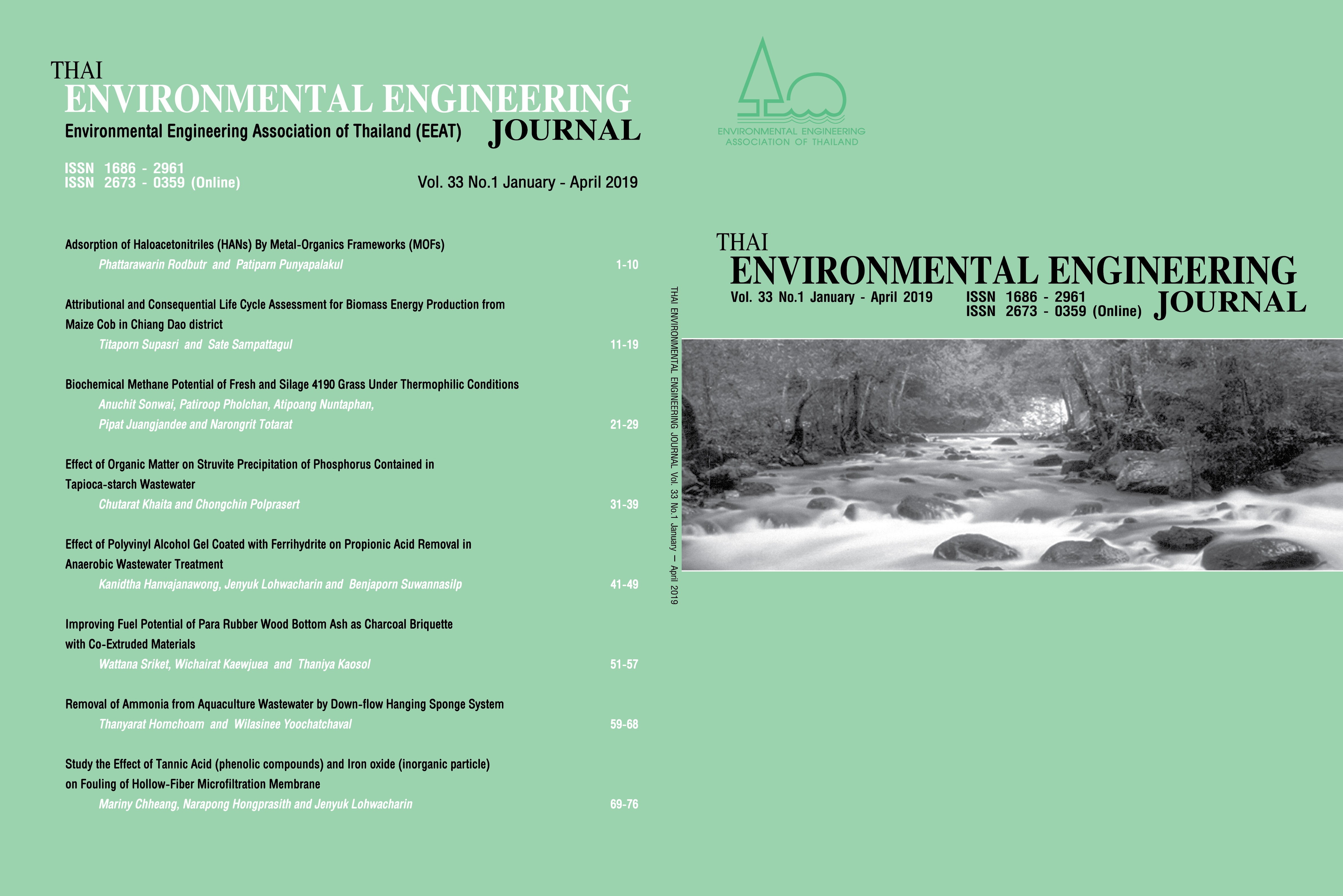Effect of Organic Matter on Struvite Precipitation of Phosphorus Contained in Tapioca-starch Wastewater
Main Article Content
Abstract
Phosphorus (P) recovery receives more attention as a means to curb water pollution caused by discharge of nutrient-laden effluent. This study was conducted so as to investigate the effect of organic matter on P recovery from raw tapioca-starch wastewater and anaerobically-digested effluent. With total COD of 17,907 mg/L, 40 mg P/L, molar ratios of Mg:Ca = 0.4:1 and Mg:N:P = 0.4:17:1, P precipitation in raw starch wastewater was found to be impeded, resulting in low P recovery efficiency of 18.2, 23.4 and 40.4% at pH = 7, 9 and 11, respectively. This may be due to low concentrations of Mg and P available for the precipitation reaction as they were bound in the organic solids. In the anaerobically-digested effluent with total COD of 4,181 mg/L, 68.mg P/L, the molar ratio of Mg:N:P was found to be 1.5:11.8:1, leading to increased P recovery efficiency of 56.5, 83.5 and 91.2% at pH = 7, 9 and 11, respectively. Overall, findings of this study reveal that the anaerobically-digested effluent is preferable to raw starch wastewater for P recovery since most P and other relevant precipitating ions (Mg2+ and NH4+) are liberated from organic solids and are readily available for chemical precipitation. Consequently, struvite precipitates formed could be used to produce a good-quality product as slow release fertilizer.
Article Details
References
[2] L. Childers D, Corman J, Edwards M. 2011. Sustainability Challenges of Phosphorus and Food: Solutions from Closing the Human Phosphorus Cycle. 117-24
[3] Cordell D, Rosemarin A, Schroder JJ, Smit AL. 2011. Towards global phosphorus security: a systems framework for phosphorus recovery and reuse options. Chemosphere. 84(6): 747-58.
[4] Bajpai P. 2017. Basics of Anaerobic Digestion Process. Anaerobic Technology in Pulp and Paper Industry. SpringerBriefs in Applied Sciences and Technology. 7-12.
[5] Darwish M, Aris A, Puteh MH, Abideen MZ, Othman MN. 2016. Ammonium-Nitrogen Recovery from Wastewater by Struvite Crystallization Technology. Separation & Purification Reviews. 45(4): 261-74.
[6] APHA. 2017. Standard Methods for the Examination of Water and Wastewater. 23rd ed. ed r, editor: American Public Health Association, American Water Works Association and Water Environment Federation, Washington, DC.
[7] Marti N, Bouzas A, Seco A, Ferrer J. 2008. Struvite precipitation assessment in anaerobic digestion processes. Chem. Eng. J. 141(1-3): 67-74.
[8] Pastor L, Marti N, Bouzas A, Seco A. 2008. Sewage sludge management for phosphorus recovery as struvite in EBPR wastewater treatment plants. Bioresour Technol. 99(11): 4817-24.
[9] Acelas NY, Flórez E, López D. 2015. Phosphorus recovery through struvite precipitation from wastewater: effect of the competitive ions. Desalin. Water Treat. 54(9): 2468-79.
[10] Le Corre KS, Valsami-Jones E, Hobbs P, Parsons SA. 2005. Impact of calcium on struvite crystal size, shape and purity. J. Cryst. Growth. 283(3): 514-22.
[11] Gunay A, Karadag D, Tosun I, Ozturk M. 2008. Use of magnesit as a magnesium source for ammonium removal from leachate. J Hazard Mater. 156(1-3): 619-23.
[12] Siciliano A, Rosa SD. 2014. Recovery of ammonia in digestates of calf manure through a struvite precipitation process using unconventional reagents. Environ. Technol. 35(7): 841-50.
[13] Yetilmezsoy K, Sapci-Zengin Z. 2009. Recovery of ammonium nitrogen from the effluent of UASB treating poultry manure wastewater by MAP precipitation as a slow release fertilizer. J Hazard Mater. 166(1): 260-9.
[14] Zhang DM, Chen YX, Jilani G, Wu WX, Liu WL, Han ZY. 2012. Optimization of struvite crystallization protocol for pretreating the swine wastewater and its impact on subsequent anaerobic biodegradation of pollutants. Bioresour Technol. 116: 386-95.


